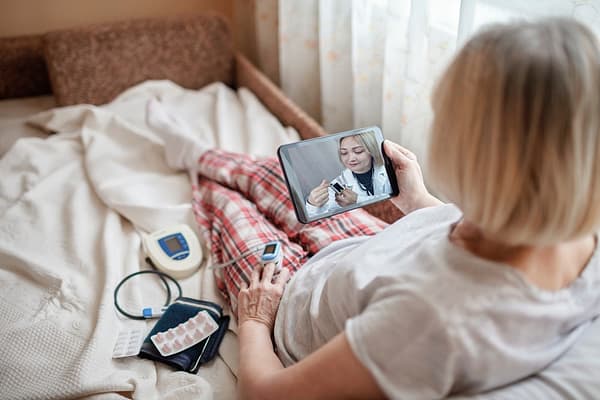In the ever-changing world of telemedicine, keeping up with the latest terms and the various applications available can be challenging. It is common for applications to become confused with one another, especially when they share similarities. One example of this is “remote patient monitoring,” and “remote patient management.”
While the two sound similar, and share a few common features, there are several key distinctions that set the two apart. Here, we will go over the key differences between these terms and highlight the features that make each virtual care solution unique.
The 3 Main Differences Between Remote Patient Monitoring & Remote Patient Management
When discussing the differences between remote patient monitoring and remote patient management, there are three major categories that can be used to compare the two:
1. Purpose of Solution
Remote Patient Monitoring: Focused on Data Collection
What sets these solutions apart from each other the most is the purpose of each solution. Remote patient monitoring tools are primarily used to collect and deliver patient health insights through the use of remote monitoring equipment. This equipment allows patients to detect early changes in their health from wherever they may be in the world, and have their data shared directly with their primary care physician or other healthcare personnel.
Remote patient monitoring equipment can measure patients’ blood sugar levels, oxygen saturation, heart rate, blood pressure, and more. Depending on a patient’s condition(s), their primary care provider can recommend the correct equipment to use and have their patients implement these changes. Commonly, patients will keep a record of this data and share their insights with their care provider during their healthcare visits.
Remote Patient Management: Focused on Improved Patient Care
Remote patient management shares some similarities with remote patient monitoring, such as using the same, or slightly more advanced monitoring tools that can be used to collect patients’ health data. The key difference between these two virtual care tools however, is the way in which this data is utilized. With remote patient management, patients are able to integrate their monitoring equipment to a virtual care platform, which can be accessed on a smart device such as a tablet or smartphone.
Patients can then have their health insights automatically shared with their primary physician, or any other members of their care circle. Through platforms that offer remote patient management, patients can also receive automated care plans or educational resources to help them begin managing symptoms immediately, rather than waiting until their next doctor’s appointment.
2. Patient Involvement
Remote Patient Monitoring: Responsible for Data Collection
The role of a patient using remote monitoring equipment varies depending on the condition of their health, and the instructions their doctor provides them with. Typically, remote patient monitoring is less engaging on the patient’s end and more geared towards providing their healthcare team with information related to their health.
It is common for patients participating in traditional remote patient monitoring to receive regular in-person care. For some, frequent in-person care can be beneficial, especially if they live in an urban setting where healthcare services are a short distance away. However, for others who may live in less populated areas, or those who have difficulties travelling to and from healthcare appointments, this can be challenging.
Remote Patient Management: Empowered to Self-Educate & Self-Manage
With remote patient management, patients are given more control over how they manage their illness. Rather than simply using monitoring equipment and reporting results to their healthcare provider, patients are able to be involved in every step of their disease management.
With platforms that offer remote patient management, such as aTouchAway, patients can see their progress, access educational resources, and meet with their care team from wherever they are, whenever they need. This can provide a number of benefits to patients, such as reducing the time they must spend getting to and from healthcare appointments, and being able to begin making lifestyle/ treatment adjustments very quickly if their symptoms exacerbate.
3. Patient Outcomes
Remote Patient Monitoring: Reactive Care Measures
When it comes to improving patient outcomes, remote patient monitoring can be an extremely useful tool. By keeping track of changing symptoms and regularly reporting them to a healthcare provider, patients can gradually learn what impacts their health, and what treatment/ management measures are helpful.
One flaw of traditional remote patient monitoring, however, is that it often forces patients to wait to begin managing their symptoms until their doctor notices any issues in their health insights. This delay may cause patients to prolong taking the measures required to improve their health, and can potentially lead them to seek emergency medical services if their condition is not treated promptly.
Remote Patient Management: Proactive Care Measures
Remote patient management offers patients a hands-on approach to improving their health outcomes. By having access to a number of practical healthcare resources in their own home, and being able to detect changing symptoms as soon as they occur, patients can begin managing their condition promptly, and improve their health outcomes.
When a proactive approach is taken in caring for an illness, there are many benefits that can be realized. With regular self management, patients can see benefits like: improved attitudes and behaviours, enhanced quality of life, reduced symptoms, and a reduced need for scarce healthcare resources.
Continuing To Improve Remote Patient Care

Whether a patient or healthcare provider chooses to utilize remote patient monitoring, or remote management, they will be able to benefit from the convenient features these solutions offer. While remote patient monitoring may be useful for patients who require less comprehensive care, solutions such as remote patient management, which offer more patient-centred features, are a more favourable option to improve overall outcomes for patients.




